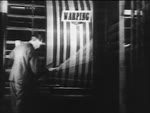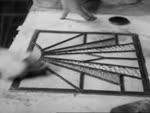INDUSTRIAL CLYDESDALE
Full length video
Please read Understanding catalogue records for help interpreting this information and Using footage for more information about accessing this film.
Title: INDUSTRIAL CLYDESDALE
Reference number: 1694
Date: 1938
Production company: Elder-Dalrymple Productions
Sound: silent
Original format: 35mm
Colour: bw
Fiction: non-fiction
Running time: 15 mins
Description:
Using diagrams, working models, and actual scenes, this film outlines the industrial development of Clydesdale, including its iron and steelworks, textile mills and shipbuilding.
Some scenes shot in Rothesay and Queen's Docks, Glasgow.
Teaching notes held at National Library of Scotland Moving Image Archive.
For review of film see Scottish Educational Film Review Volume 1, Review No. 129.
Credits: The working models in this film were photographed in the Art Galleries and Museum, Kelvingrove, through the courtesy of the Corporation of Glasgow. [Distributed by Educational and General Services Limited]
Shotlist: Credits (.18) gvs colliery (1.01) The industrial development of Clydesdale began about the beginning of the 19th centry following the discovery that coal could be used for smelting iron ore. gvs Dixon's Iron Works, Glasgow, shots iron production on sand beds (2.20) Iron works were built beside the mines. Map coalfield area with iron and steelwork locations in Clyde Valley area (2.48) About the same time, improvements to the steam engine made textile mills independent of water power. Shots stem engines (3.04) The use of steam engines for driving ships began on the Forth and Clyde Canal in 1802 with the little ship "Charlotte Dundas". Model of ship (3.21) A model of the "Charlotte Dundas" beside the model of a present day liner and the model of one of the liner's several engines. shots same (3.34) The demand for iron increased greatly in the middle of the century when ships were built of iron and later steel instead of wood. Model wooden vessel. Iron ship's skeleton (3.52) Plates and girders are made in the steelworks of Lanarkshire for the shipyards on the Clyde. Int. of shipyards (5.14) Ext. of shipyards (5.27) Thousands of people moved from the Highlands to work in the mines, mills, ironworks and shipyards .. Population diagram for Clyde Valley for 1801, 1851, 1901 (5.59) .. leaving the Highlands even more lonely. Occupied Highland croft beside abandoned one (6.15) ..and filling the towns. Shot workforce leaving place of work (6.26) l/s Glasgow (6.33) street scenes (6.54) The River Clyde was deepened and docks were built at Glasgow to take large ships. ships on Clyde, shot of "City of Benares" (7.27) l/s docks (7.40) ships bring food for the people. Cargoes being unloaded. c/u of box labels, one contains oranges (8.15) Ore and other raw materials for the works. Raw materials unloaded (8.49) And carry away the products of the factories. Cargo loaded for export. Crane lifts double-decker bus onto vessel. Miscellaneous items loaded, including Singer sewing machines (8.38) Ships take on supplies of coal for their voyages. Shot "City of Benares" (9.49) coal loaded onto her (10.06) Many other industries have been established. Chemical works; Bridge building; Textile mills; Sewing machine manufacture; Printing; Sawmills, Engineering; Furniture making. So today the Clyde basin is one of the world's greatest industrial centres. Caption (10.45)






